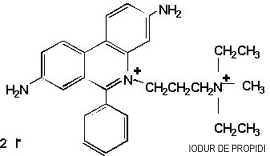What are they?
Ethidium bromide is a fluorescent dye of the phenanthridinium salt family. Synonyms: 3,8-diamino-5-ethyl-6-phenylphenylanthridinium bromide; EtBr. Its molecular formula is C21H20N3Br, its molecular weight is 394.3 and its CAS number is 1239-45-8. Its physical appearance is solid and its colour is red.
Propidium iodide is a fluorescent dye of the same family as ethidium bromide. It is mutagenic, but to a lesser extent than ethidium bromide, and could replace it in most of its uses. Synonyms: 3,8-diamino-5-(3-(diethylmethylammonium)propyl)-6-phenylphenanthridine diiodide; propidium diiodide. Its molecular formula is C27H34N4I2, its molecular weight is 668.4 and its CAS number is 25535-16-4. Its physical appearance is powdery and its colour is red.


What are they mainly used for?
Ethidium bromide: a dye widely used in molecular biology to visualise DNA.
Propidium iodide: a dye widely used in cytology, particularly in cytofluorometry.
Both compounds are intercalating agents: they intercalate between the base pairs of nucleic acids. (Ethidium bromide intercalates mainly at the mitochondrial DNA level).
Why are they dangerous?
| ETHYDIUM BROMIDE | PROPIDIUM IODIDE | ||
|---|---|---|---|
| Hazard classification | This product is classified as hazardous according to Regulation (EC) 1272/2008 | This product is classified as hazardous according to Regulation (EC) 1272/2008 | |
| Toxic | Mutagenic | Mutagenic | |
| Indication(s) of danger (H phrases) | – H331 Toxic if inhaled. – H341 Suspected of causing genetic defects. | – H341 Suspected of causing genetic defects. | |
| Statement(s) of prudence (phrases) P) | – P202 Do not handle the substance until all safety instructions have been read and understood. – P261 Avoid breathing dust/fume/gas/mist/vapours/spray. – P271 Use only outdoors or in a well-ventilated area. – P280 Wear gloves/protective clothing/eye/face protection. – P304 + P340 + P311 IF INHALED: Remove person to fresh air and keep comfortable for breathing. Call a POISON CENTER/ doctor. – P308 + P313 IF exposed or concerned: Get medical advice/attention. | – P201 Obtain special instructions before use. – P202 Do not handle the substance until all safety instructions have been read and understood. – P280 Wear gloves/protective clothing/eye/face protection. – P308 + P313 IF exposed or concerned: Get medical advice/attention. – P405 Store locked up. – P501 Dispose of contents/container to an authorized waste disposal plant. |
Destruction and decontamination procedures.
Destruction
- Put in a 250 ml container, under magnetic agitation, 100 ml of a solution containing 50 mg of ethidium bromide (0.5 mg/ml).
- Add 20 ml of a 5% hypophosphorous acid solution (stock solution: 90 ml of water plus 10 ml of 50% commercial hypophosphorous acid).
- Add 12 ml of an aqueous solution of sodium nitrite 0.5 M (34.5 g/l).
- Leave in agitation for a few minutes (progressive degassing).
- Let it stand for 20 hours.
- Neutralize with sodium bicarbonate.
- Eliminate the excess water.
It is likely that this technique can be used under the same conditions for the destruction of propidium iodide.
Descontamination
- Add to 100 ml of a solution containing 100 m g/ml (0.1 mg/ml) of ethidium bromide, 2.9 g of Amberlite XAD-16.
- After mixing for 20 hours, filter the mixture and classify the solid waste as hazardous waste.
- Discard the filtering, which should appear transparent.
For 100 ml of solution containing propidium iodide, it is necessary to use 5 grams of Amberlite XAD-16 resin.
Bibliographic references
- Picot, A., Grenouillet, P. “Destruction du bromure d’éthidium et de l’iodure de propidium” a La Sécurité en laboratorire de chimie et de biochimie, cap IV.
- “Disposal of ethidium bromide”. TIBS. June, 1994: 257-8.
- Lunn, G., Sansone, E.B. “Ethidium bromide: destruction and decontamination of solutions”. Analytical Biochemistry 162 p. 453-458 (1987).